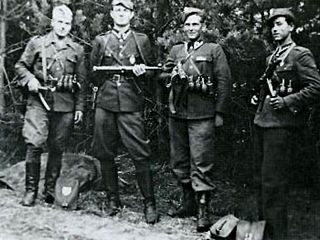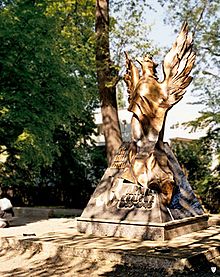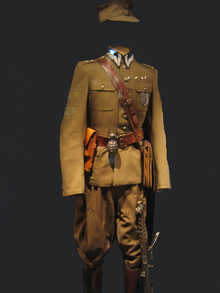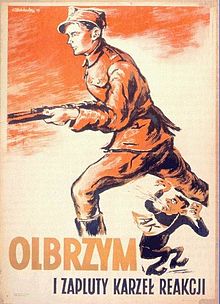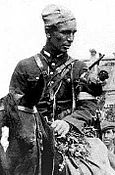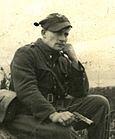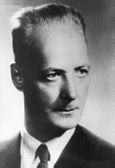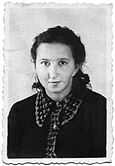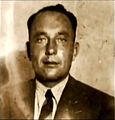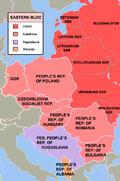- Cursed soldiers
-
The 'cursed soldiers' (Polish: Żołnierze wyklęci) is a name applied to a variety of Polish resistance movements formed in the later stages of World War II and afterwards. Created by some members of the Polish Secret State, these clandestine organizations continued their armed struggle against the Stalinist government of Poland well into the 1950s. The guerrilla warfare included an array of military attacks launched against the new communist prisons as well as MBP state security offices, detention facilities for political prisoners, and concentration camps set up across the country. Most of the Polish anti-communist groups ceased to exist in the late 1940s or 1950s, hunted down by MBP security services and NKVD assassination squads.[1] However, the last known 'cursed soldier', Józef Franczak, was killed in an ambush as late as 1963, almost 20 years after the Soviet take-over of Poland.[2][3]
For more details on this topic, see Anti-communist resistance in Poland (1944–1946).The best-known Polish anti-communist resistance organizations operating in Stalinist Poland included Freedom and Independence (Wolność i Niezawisłość, WIN), National Armed Forces (Narodowe Siły Zbrojne, NSZ), National Military Union (Narodowe Zjednoczenie Wojskowe, NZW), Konspiracyjne Wojsko Polskie (Underground Polish Army, KWP), Ruch Oporu Armii Krajowej (Home Army Resistance, ROAK), Armia Krajowa Obywatelska (Citizens' Home Army, AKO), NIE (NO, short for Niepodległość), Armed Forces Delegation for Poland (Delegatura Sił Zbrojnych na Kraj), and Wolność i Sprawiedliwość (Freedom and Justice, WiS).[3] Similar Eastern European Anti-Communist Insurgencies fought on in other countries.
Contents
Historical background
With the advance of Soviet forces across Poland against Nazi Germany, the Soviet and Polish communists who set up the brand new government called the Polish Committee of National Liberation in 1944, realized that the Polish Secret State loyal to the Polish government-in-exile, had to be abolished before they could gain complete control over Poland.[4] Future General Secretary of PZPR, Władysław Gomułka, pronounced that "Soldiers of AK are a hostile element which must be removed without mercy". Another prominent communist, Roman Zambrowski, ushered that the AK had to be "exterminated".[5]
Armia Krajowa (or simply AK) – the main Polish resistance movement in World War II – had officially disbanded on 19 January 1945 to prevent a slide into armed conflict with the Red Army including an increasing threat of civil war over Poland's sovereignty. However, many units decided to continue on their struggle under new circumstances, seeing the Soviet forces as new occupiers. Meanwhile, Soviet partisans in Poland had already been ordered by Moscow on June 22, 1943 to engage Polish Leśni partisans in combat.[6] They commonly fought Poles more often than they did the Germans.[4] The main forces of the Red Army (Northern Group of Forces) and the NKVD began conducting operations against AK partisans already during and directly after the Polish Operation Tempest designed by the Poles as a preventive action to assure Polish rather than Soviet control of the cities after the German withdrawal.[5] Stalin aimed to ensure that an independent Poland would never reemerge in the postwar period.[7]
Formation of the anti-communist underground
The first AK structure designed primarily to deal with the Soviet threat was the NIE, formed in mid-1943. NIE's goal was not to engage the Soviet forces in combat, but rather to observe and conduct espionage while the Polish government-in-exile decided how to deal with the Soviets. At that time, the exiled government still believed that the solution could be found through negotiations. On May 7, 1945, the NIE ("NO") was disbanded and transformed into the Delegatura Sił Zbrojnych na Kraj ("Armed Forces Delegation for Homeland"). However, this organization lasted only until August 8, 1945, when the decision was made to disband it and to stop partisan resistance on Polish territory.[5]
In March 1945 a staged trial of 16 leaders of the Polish Underground State held by the Soviet Union took place in Moscow - (the Trial of the Sixteen).[8][9][10][11] The Government Delegate, together with most members of the Council of National Unity and the C-i-C of the Armia Krajowa, were invited by Soviet general Ivan Serov with agreement of Joseph Stalin to a conference on their eventual entry to the Soviet-backed Provisional Government. They were presented with a warrant of safety, but the NKVD arrested them in Pruszków on 27 and 28 March.[12][13] Leopold Okulicki, Jan Stanisław Jankowski and Kazimierz Pużak were arrested on 27th with 12 more the next day. A.Zwierzynski had been arrested earlier. They were brought to Moscow for interrogation in the Lubyanka.[14][15][16] After several months of brutal interrogation and torture[17] they were presented with the forged accusations of "collaboration with Nazi Germany" and of "planning a military alliance with Nazi Germany".[18][19]
The first Polish communist government, PKWN, was formed in July 1944, but declined jurisdiction over AK soldiers. Consequently, for more than a year, it was Soviet agencies like the NKVD that dealt with the AK. By the end of the war, approximately 60,000 soldiers of the AK had been arrested, and 50,000 of them were deported to the Soviet Union's gulags and prisons. Most of those soldiers had been captured by the Soviets during or in the aftermath of Operation Tempest, when many AK units tried to cooperate with the Soviets in a nationwide uprising against the Germans. Other veterans were arrested when they decided to approach the government after being promised amnesty. In 1947, an amnesty was passed for most of the partisans; the Communist authorities expected around 12,000 people to give up their arms, but the actual number of people to come out of the forests eventually reached 53,000. Many of them were arrested despite promises of freedom; after repeated broken promises during the first few years of communist control, AK soldiers stopped trusting the government.[5]
The third AK organization was Wolność i Niezawisłość ("Freedom and Sovereignty"). Again, its primary goal was not combat; rather, the WiN was designed to help AK soldiers make the transition from a life as partisans to that of civilians. The continued secrecy and conspiracy were necessary in light of the increasing persecution of AK veterans by the communist government. WiN was, however, much in need of funds to pay for false documents and to provide resources for the partisans, many of whom had lost their homes and entire life-savings in the war. Viewed as enemies of the state, starved of resources, and with a vocal faction advocating armed resistance against the Soviets and their Polish proxies, WiN was far from efficient. A significant victory for the NKVD and the newly created Polish secret police, Urząd Bezpieczeństwa (UB), came in the second half of 1945, when they managed to convince several leaders of the AK and WiN that they truly wanted to offer amnesty to AK members. Within a few months, they managed to gain information about vast numbers of AK/WiN resources and people. Several months later when the (imprisoned) AK and WiN leaders realized their mistake, the organization was crippled and thousands more of their members were arrested.[5] WiN finally disbanded in 1952.
Persecution
The NKVD and UB used brute force and deception to eliminate the underground opposition. In the autumn of 1946, a group of 100–200 soldiers of Narodowe Siły Zbrojne (National Armed Forces, NSZ) were lured into a trap and massacred. In 1947, Colonel Brystiger ("Bloody Luna") of MBP declared at the secutity briefing, that "The terrorist and political underground had ceased to be a threatening force," although the class enemy at universities, offices and factories still needs to be "found out and neutralized."[5]
The persecution of the AK members was only a part of the rein of Stalinist terror in postwar Poland. In the period of 1944–56, approximately 300,000 Polish people had been arrested,[20] or up to two million, by different accounts.[5] There were 6,000 death sentences issued, the majority of them carried out.[20] Possibly, over 20,000 people died in communist prisons including those executed "in the majesty of the law" such as Witold Pilecki, a hero of Auschwitz.[5] A further six million Polish citizens (i.e., one out of every three adult Poles) were classified as suspected members of a 'reactionary or criminal element' and subjected to investigation by state agencies. During the Polish October of 1956, a political amnesty freed 35,000 former AK soldiers from prisons. Still, some partisans remained in service, unwilling or simply unable to rejoin the community. The cursed soldier Stanisław Marchewka "Ryba" ("The Fish") was killed in 1957; and the last AK partisan, Józef Franczak "Lalek" ("Doller"), was killed in 1963 — almost two decades after the Second World War ended. Four years later, long after the abolition of Stalinist terror, last member of the elite British-trained Cichociemny ("The Silent and Hidden") intelligence and support group Adam Boryczka was finally released from prison (1967). Until the end of the People's Republic of Poland, former AK soldiers were under constant investigation by the secret police. It was only in 1989, after the fall of communism, that the court sentences of AK soldiers were finally declared invalid and annulled by the Polish law.[5]
The largest operations and actions
Main article: Anti-communist resistance in Poland (1944–1946)The biggest battle in the history of the National Military Union (Narodowe Zjednoczenie Wojskowe, NZW) took place on May 6–7, 1945, in the village of Kuryłówka in southeastern Poland. The Battle of Kuryłówka fought against the Soviet 2nd Border Regiment of the NKVD, ended in a victory for the underground forces commanded by Major Franciszek Przysiężniak ("Marek"). The anti-communist fighters killed up to 70 Russian agents. The NKVD troops retreated in haste, only to reappear in the village later on and burn it to the ground in retaliation, destroying over 730 buildings.[21][22]
On May 21, 1945, a heavily-armed unit of the Home Army (AK) led by Colonel Edward Wasilewski, attacked and destroyed the NKVD camp located in Rembertów on the eastern outskirts of Warsaw. The Russians incarcerated there many hundreds of Polish citizens,[23][24][25] including members of the Home Army,[26] who were systematically deported to Siberia. The attack freed all Polish political prisoners from the camp. Between 1944-1946, the Cursed soldiers liberated many communist prisons in Soviet occupied Poland. For a more complete list of their operations see Polish anti-communist resistance.
Retaliation
One of the biggest communist anti-partisan operations took place from June 10 to June 25, 1945, in and around the Suwałki and Augustów regions of Poland. The Augustów roundup (Polish: Obława augustowska) was a joint operation of the Red Army and the Soviet NKVD and SMERSH battalions with the assistance from Polish UB and LWP units, against underground Armia Krajowa soldiers. The Soviet operation extended into the territory of occupied Lithuania. More than 2,000 Polish suspected anti-communist fighters were captured and detained in Russian internment camps. About 600 of the "Augustow Missing" are presumed dead and buried in unknown mass graves on the present territory of Russia. The Polish Institute of National Remembrance has declared the 1945 Augustów roundup "the largest crime committed by the Soviets on Polish lands after World War II."[27]
Anti-communist resistance organizations
Among the best-known Polish underground organizations,[3] engaged in guerrilla warfare were:
- Wolność i Niezawisłość (Freedom and Independence, WIN) founded on September 2, 1945, active to 1952.
- Narodowe Siły Zbrojne (National Armed Forces, NSZ) created on September 20, 1942, split in March 1944.
- Narodowe Zjednoczenie Wojskowe (National Military Union, NZW) established in mid-to-late 1940s, active until mid-1950s.
- Konspiracyjne Wojsko Polskie (Underground Polish Army, KWP) which existed from April 1945 to as late as 1954.
- Ruch Oporu Armii Krajowej (Resistance of the Home Army, ROAK) formed in 1944 against UB collaborators.
- Armia Krajowa Obywatelska (Citizens' Home Army, AKO) founded in February 1945, incorporated into Wolność i Niezawisłość in 1945.
- NIE (NO) formed in 1943, active till 7 May 1945.
- Delegatura Sił Zbrojnych na Kraj (Delegature of the Polish Forces at Home) formed on May 7, 1945, dissolved on August 8, 1945.
- Wolność i Sprawiedliwość (Freedom and Justice, WIS) founded in early 1950s.
Notable members
- Cpt. Józef Batory, pseudonyms "Argus", "Wojtek"
- Lt. Stefan Bembiński, pseudonym "Harnaś"
- Maj. Marian Bernaciak, pseudonyms "Orlik", "Dymek"
- Lt. Ksawery Błasiak, pseudonym "Albert"
- Cpt. Franciszek Błażej, pseudonyms "Roman", "Bogusław", "Tadeusz"
- Lt. Stanisław Bogdanowicz, pseudonym "Tom"
- Lt. Col. Janusz Bokszczanin, pseudonym "Sęk"
- Lt. Stefan Bronowski, pseudonym "Roman"
- Cpt. Zdzisław Broński, pseudonym "Uskok"
- Lt. Karol Chmiel, pseudonym "Grom", "Zygmunt"
- Lt. Kazimierz Chmielowski, pseudonym "Rekin"
- Lt. Col. Łukasz Ciepliński, pseudonyms "Pług", "Ostrowski"
- Maj./Lt. Col. of NSZ Tadeusz Danilewicz, pseudonyms "Kuba", "Doman", "Kossak", "Łoziński"
- Maj. Hieronim Dekutowski, pseudonym "Zapora"
- Cpt. Jan Karol Dubaniowski, pseudonym "Salwa
- 2nd Lt. Władysław Dubielak, pseudonym "Myśliwy"
- Brig. Gen.Emil August Fieldorf, pseudonym "Nil"
- Cpt. Henryk Flame, pseudonym "Bartek", "Grot"
- Józef Franczak, pseudonym "Lalek"
- Lt. Henryk Glapiński, pseudonym "Klinga"
- Lt. Eugeniusz Godlewski, pseudonym "Topór"
- Maj. Antoni Heda, pseudonym "Szary"
- Lt. Col. Tadeusz Jachimek, pseudonym "Ninka"
- Lt. Franciszek Jerzy Jaskulski, pseudonym "Zagończyk"
- 2nd Lt. Henryk Jóźwiak, pseudonym "Groźny"
- Cpt. Kazimierz Kamieński, pseudonym "Huzar"
- 2nd Lt./Lt. Col of NSZ Stanisław Kasznica, pseudonyms "Wąsowski", "Przepona", "Wąsal"
- Lt. Col. Mieczysław Kawalec, pseudonyms "Iza", "Psarski", "Bronek
- Lt. Jan Kempiński pseudonym "Błysk"
- Lt. Stefan Kobos, pseudonym "Wrzos"
- Cpt. Jan Kosowski, pseudonym "Ciborski"
- Lt. Karol Kazimierz Kostecki, pseudonym "Kostek"
- Lt. Jan Kłyś, pseudonym "Kłyś"
- Lt. Michał Krupa, pseudonyms "Wierzba", "Pulkownik"
- Col./Brig. Gen. (posthumous recognition) Aleksander Krzyżanowski, pseudonym "Wilk"
- Cpt. Ludwik Kubik, pseudonyms "Alfred", "Julian", "Lucjan"
- Lt. Józef Kuraś, pseudonym "Ogień"
- 2nd Lt. Adam Kusz, pseudonym "Garbaty"
- 2nd Lt. Władysław Kuśmierczyk, pseudonym "Longinus"
- Lt. Col. Wincenty Kwieciński, pseudonym "Głóg"
- Maj. Adam Lazarowicz, pseudonyms "Klamra", "Pomorski", "Kleszcz", "Zygmunt"
- Lt. Col. Henryk Lewczuk, pseudonym "Młot"
- Lt. Col. Władysław Liniarski, pseudonyms "Mścisław", "Wuj", "Jan"
- Lt. Stanisław Łukasik, pseudonym "Ryś"
- Cpt. Władysław Łukasiuk, pseudonym "Młot"
- Lt. Col. Józef Maciołek, pseudonyms "Żuraw", "Kazimierz", "Marian", "Roch"
- Cpt. Jan Marawca, pseudonym "Remiusz"
- 2nd Lt. Stanisław Marchewka, pseudonym "Ryba"
- Lt. Józef Marcinkowski, pseudonym "Łysy"
- 2nd Lt. Lucjan Minkiewicz, pseudonym "Wiktor"
- Maj. Kazimierz Mirecki, pseudonym "Zmuda"
- Cpt. Lech Neyman, pseudonym "Domarat"
- 2nd Lt. Mieczysław Niedzielski, pseudonyms "Men", "Grot"
- Col. Franciszek Niepokólczycki, pseudonym "Szubert"
- Lt. Wiktor Zacheusz Nowowiejski, pseudonym "Jeż"
- Maj. Mieczysław Pazderski, pseudonym "Szary"
- Lt. Stanisław Pelczer, pseudonym "Majka"
- Cpt. Witold Pilecki, pseudonym "Witold"
- Lt. Franciszek Przysiężniak, pseudonym "Ojciec Jan"
- Cpt. Romuald Rajs, pseudonym "Bury"
- Lt. Col. Albin Rak, pseudonym "Lesiński"
- Lt. Józef Ramatowski, pseudonym "Rawicz"
- Cpt. Wacław Rejmak, pseudonym "Ostoja"
- Maj. Zygmunt Rogalski, pseudonym "Kacper"
- Lt. Jan Rogólka, pseudonym "Grot"
- Col. Kazimierz Rolewicz, pseudonyms "Kama", "Ira", "Oko", "Mila", "Olgierd", "Zbyszek", "Solski"
- Lt. Lechosław Roszkowski, pseudonym "Tomasz"
- Lt. Col. Józef Rybicki, pseudonym "Mestwin"
- Maj. Aleksander Rybnik, pseudonyms "Jerzy", "Dziki"
- Maj. Józef Rządzki, pseudonym "Boryna"
- Lt. Józef Rzepka, pseudonyms "Krzysztof", "Znicz"
- Col. Antoni Sanojca, pseudonym "Kortum"
- Lt. Col. Stanisław Sędziak, pseudonyms "Wiatr", "Warta"
- Danuta Siedzikówna, pseudonym "Inka"
- Cpt. Stanisław Sojczyński, pseudonym "Warszyc"
- Sgt. Władysław Stefanowski, pseudonym "Grom"
- Maj. Stanisław Szacoń, pseudonym "Szacun"
- Lt. Col. Jan Szczurek-Cergowski, pseudonym "Sławbor"
- Maj. Zygmunt Szendzielarz, pseudonym "Łupaszko"
- 2nd Lt. Teodor Śmiałowski, pseudonyms "Szumny", "Grom", "Cichy"
- Maj. Jan Tabortowski, pseudonym "Bruzda"
- 2nd Lt. Edward Taraszkiewicz, pseudonym "Żelazny"
- 2nd Lt. Leon Taraszkiewicz, pseudonym "Jastrząb"
- Lt. Col. Walerian Tumanowicz, pseudonym "Jagodziński"
- 2nd Lt. Edmund Tudraj, pseudonym "Mundek"
- 2nd Lt.. Eugeniusz Walewski, pseudonym "Zemsta"
- Cpt. Józef Zadzierski, pseudonym "Wołyniak"
See also
- NZW Battle of Kuryłówka
- Augustów roundup (Polish: Obława augustowska)
- Polish Leśni partisans
- Attack on the NKVD Camp in Rembertów
- 1951 Mokotow Prison execution
- Western betrayal regarding Eastern and Central Europe
- Baltic Forest Brothers
- Romanian anti-communist resistance movement
- Ukrainian Insurgent Army
- Japanese holdout
References
- ^ Tennent H. Bagley (2007). "Spy wars: moles, mysteries, and deadly games". Yale University Press. pp. 120. ISBN 0300121989. http://books.google.ca/books?id=Ng7myCguewAC&pg=PA120&dq=%22puppet+government+they+had+set+up%22+%22formally+disbanded+the+AK%22&hl=en&ei=KgrcTb8fxtjRAefeodAP&sa=X&oi=book_result&ct=result&resnum=1&ved=0CCoQ6AEwAA#v=onepage&q=%22puppet%20government%20they%20had%20set%20up%22%20%22formally%20disbanded%20the%20AK%22&f=false. Retrieved May 24, 2011.
- ^ "Żołnierze wyklęci: Antykomunistyczne podziemie po 1945 roku". Muzeum Podkarpackie, Krosno. 2007. Archived from the original on May 3, 2007. http://web.archive.org/web/20070503203703/http://www.muzeum.krosno.pl/archiwum/zolnierze_wykleci/zolnierze.htm. Retrieved May 29, 2011. "w 50 lat po zamordowaniu członków IV Zarządu Głównego Zrzeszenia Wolność i Niezawisłość" (Polish)
- ^ a b c Agnieszka Adamiak, Oddziałowe Biuro Edukacji Publicznej (2001). "Żołnierze wyklęci. Antykomunistyczne podziemie na Rzeszowszczyźnie po1944 roku". Institute of National Remembrance. http://www.ipn.gov.pl/portal/pl/359/925/. Retrieved May 29, 2011. (Polish)
- ^ a b Review of Sowjetische Partisanen in Weißrußland, by Marek Jan Chodakiewicz, in Sarmatian Review, April 2006.
- ^ a b c d e f g h i Andrzej Kaczyński, Rzeczpospolita, 02.10.04 Nr 232, Wielkie polowanie: Prześladowania akowców w Polsce Ludowej (Great hunt: the persecutions of AK soldiers in the People's Republic of Poland), last accessed on 7 June 2006 (Polish).
- ^ Tadeusz Piotrowski, Poland's Holocaust, McFarland & Company, 1997, ISBN 0-7864-0371-3. Google Print, pp. 88, 89, 90.
- ^ Judith Olsak-Glass, Review of Piotrowski's Poland's Holocaust in Sarmatian Review, January 1999.
- ^ Prazmowska, A. (2004) Civil war in Poland, 1942-1948 Palgrave ISBN 0-333-98212-6 Page 115
- ^ Malcher, G.C. (1993) Blank Pages Pyrford Press ISBN 1 897984 00 6 Page 73
- ^ Mikolajczyk, S. (1948) The pattern of Soviet domination Sampson Low, Marston & Co Page 125
- ^ Garlinski, J.(1985) Poland in the Second World War Macmillan ISBN 0-333-39258-2 Page 324
- ^ Prazmowska, A. (2004) Civil war in Poland, 1942-1948 Palgrave ISBN 0-333-98212-6 Page 116
- ^ Michta, A. (1990) Red Eagle Stanford University ISBN 0-8179-8862-9 Page 39
- ^ Garlinski, J.(1985) Poland in the Second World War Macmillan ISBN 0-333-39258-2 Page 325-326
- ^ Umiastowski, R. (1946) Poland, Russia and Great Britain 1941-1945 Hollis & Carter Pages 462-464
- ^ Piesakowski, T. (1990) The fate of Poles in the USSR 1939~1989 Gryf Pages 198-199
- ^ Garlinski, J.(1985) Poland in the Second World War Macmillan ISBN 0-333-39258-2 Page 335
- ^ Garlinski, J.(1985) Poland in the Second World War Macmillan ISBN 0-333-39258-2 Page 336
- ^ Umiastowski, R. (1946) Poland, Russia and Great Britain 1941-1945 Hollis & Carter Pages 467-468
- ^ a b "Otwarcie wystawy „Zbrodnie w majestacie prawa 1944–1956” – Kraków, 2 lutego 2006". Instytut Pamięci Narodowej. http://www.ipn.gov.pl/portal/pl/2/1002/Otwarcie_wystawy_8222Zbrodnie_w_majestacie_prawa_1944821119568221_8211_Krakow_2_.html. Retrieved June 01, 2011.
- ^ Urząd Gminy Kuryłówka. "Kuryłówka village. Calendarium". Portal Podkarpacki. http://epodkarpacie.com/index.php?page=guide&main_guide_id=60&usection_id=275&poll_id=1. Retrieved May 30, 2011.
- ^ Norman Davies, No Simple Victory, Viking Penguin, 2006.[page needed]
- ^ Norman Davies, Rising '44, 2004, Viking Penguin, ISBN 0-670-03284-0, p. 495
- ^ Norman Davies, Rising '44, 2003, Macmillan, ISBN 0-333-90568-7, p. 495
- ^ Norman Davies, Rising '44, 2004, Pan, ISBN 0-330-48863-5, p. 497
- ^ Tadeusz Piotrowski, Poland's Holocaust: Ethnic Strife, Collaboration with Occupying Forces and Genocide in the Second Republic, 1918-1947, McFarland & Company, 1998, ISBN 0786403713, p.131 (Google Print)
- ^ "Konferencja IPN: "60. rocznica obławy augustowskiej." (IPN Conference on the 60th Anniversary of the Augustów roundup)". Instytut Pamięci Narodowej. 20 July 2005. http://www1.ipn.gov.pl/portal.php?serwis=pl&dzial=177&id=816. Retrieved May 30, 2011. (Polish)
Further reading
- Jerzy Ślaski, Żołnierze wyklęci, Warszawa, Oficyna Wydawnicza Rytm, 1996
- Grzegorz Wąsowski and Leszek Żebrowski, eds., Żołnierze wyklęci: Antykomunistyczne podziemie zbrojne po 1944 roku, Warszawa, Oficyna Wydawnicza Volumen and Liga Republikańska, 1999
- Kazimierz Krajewski et al., Żołnierze wyklęci: Antykomunistyczne podziemie zbrojne po 1944 r., Oficyna Wydawnicza Volumen and Liga Republikańska, 2002
- Tomasz Łabuszewski, Białostocki Okręg AK- AKO : VII 1944-VIII 1945 (Warszawa: Oficzna Wydawnicza Volumen and Dom Wydawniczy Bellona, 1997
- Zrzeszenie “Wolność i Niezawisłość” w dokumentach, 6 vols. (Wrocław: Zarząd Główny WiN, 1997–2001)
- Zygmunt Woźniczka, Zrzeszenie “Wolność i Niezawisłość” 1945-1952 (Warszawa: Instytut Prasy i Wydawnictw “Novum” – “Semex”, 1992)
- Marek Latyński, Nie paść na kolana: Szkice o opozycji lat czterdziestych (London: Polonia Book Fund Ltd., 1985)
External links
- (English) Short description of an exhibition on Łupaszko
- (English) The Doomed soldiers - Polish Underground Soldiers 1944-1963 - The Untold Story
- (English) WiN | Freedom and Independence - Historical Brief.
- (English) NSZ | National Armed Forces - Historical Brief.
- (Polish) Broader description
- (Polish) ŻOŁNIERZE WYKLĘCI NA KRESACH POŁUDNIOWO-WSCHODNICH PO 1944 R.
- (Polish) Antykomunistyczne Podziemie Zbrojne po 1944 roku
- (Polish) Żołnierze wyklęci
Eastern Bloc Formation Annexed as, or into, SSRs Eastern Finland · Estonia · Latvia · Lithuania · Memel · East Prussia · West Belarus · Western Ukraine · Moldavia · Uzbekistan · Kazachstan · Azerbaijan · Georgia · Tajikstan · Kirgizstan · Turkmenistan · ArmeniaAnnexing SSRs Related organizations Revolts and opposition Welles Declaration · The Goryani Movement · Forest Brothers · Operation Jungle · State continuity of the Baltic states · Baltic Legations (1940–1991) · Cursed soldiers · Uprising in Plzeň (1953) · Uprising of 1953 in East Germany · 1956 Georgian demonstrations · Poznań 1956 protests · Hungarian Revolution of 1956 · Novocherkassk massacre · Prague Spring and Warsaw Pact invasion of Czechoslovakia · 1968 Red Square demonstration · Polish 1970 protests · June 1976 protests · Solidarity, Soviet reaction and Martial law · Reagan Doctrine · Jeltoqsan · April 9 tragedy · Romanian Revolution of 1989 · Black JanuaryConditions Eastern Bloc emigration and defection · Sovietization of the Baltic states · Eastern Bloc information dissemination · Eastern Bloc politics · Eastern Bloc economies · Telephone tapping in the Eastern Bloc · List of Eastern Bloc defectorsDecline Revolutions of 1989 · Fall of the Berlin Wall · Fall of communism in Albania · Singing Revolution · Collapse of the Soviet Union · Dissolution of Czechoslovakia · January 1991 events in Lithuania · January 1991 events in LatviaCategories:- Cursed soldiers
- Anti-communism
- Polish resistance fighters
- History of Poland (1945–1989)
- Anti-communism in Poland
Wikimedia Foundation. 2010.

